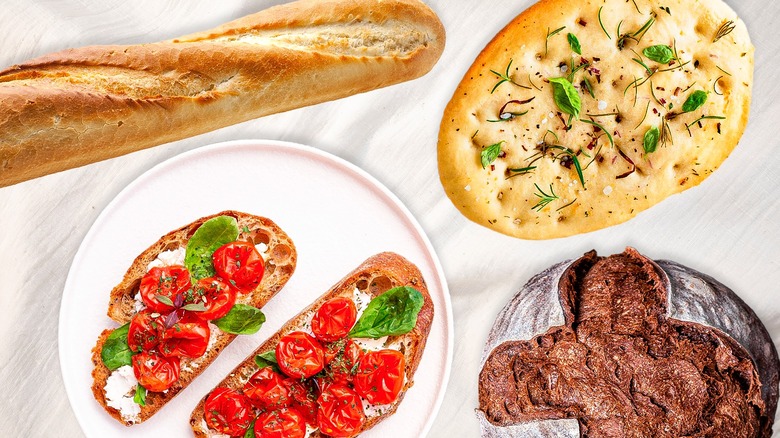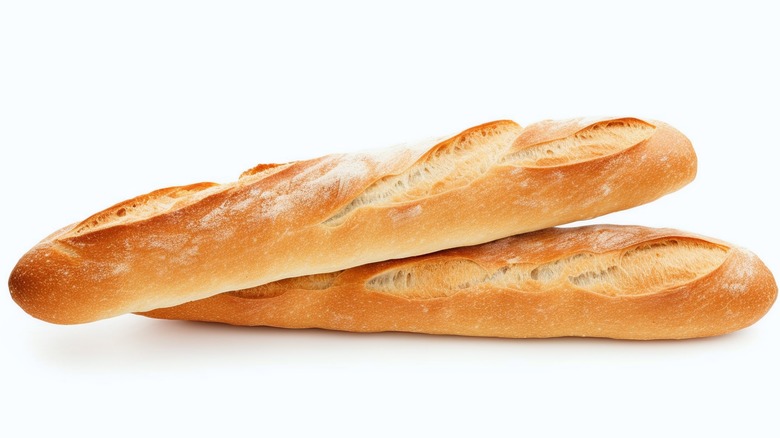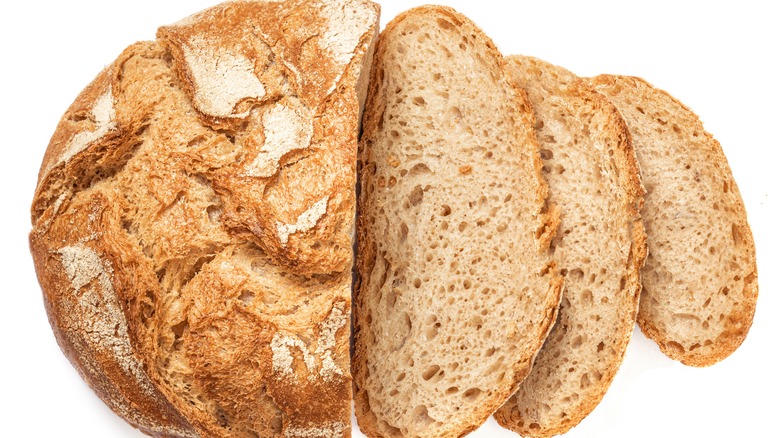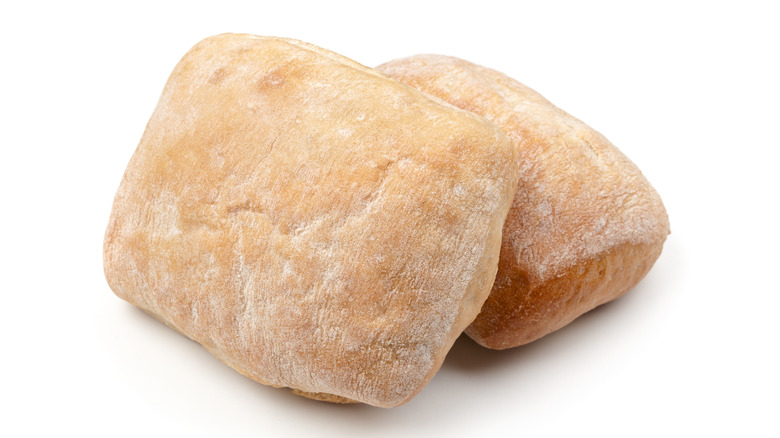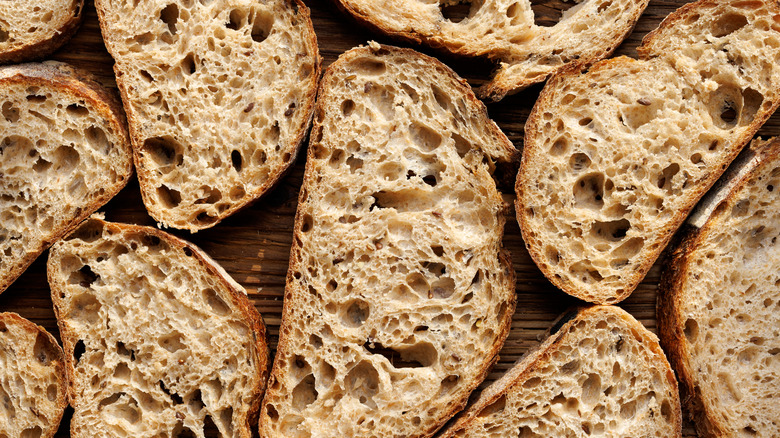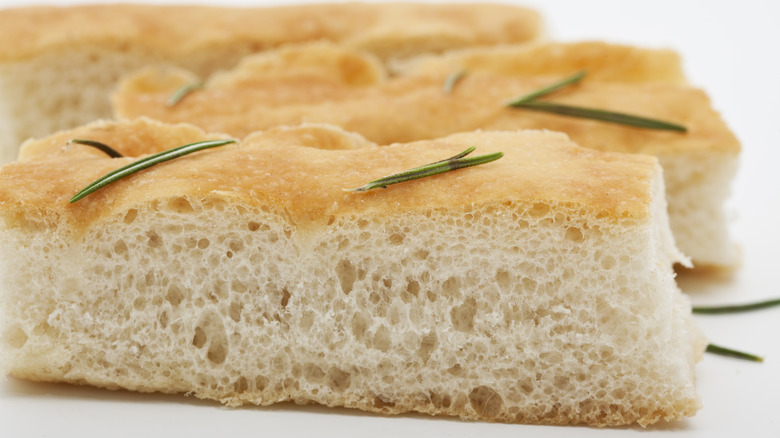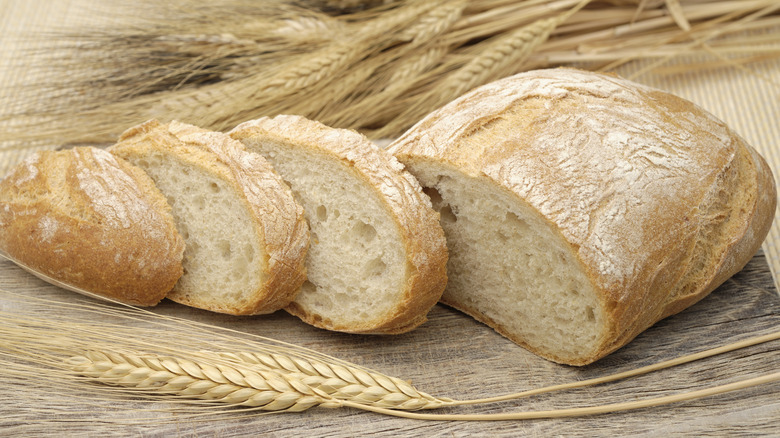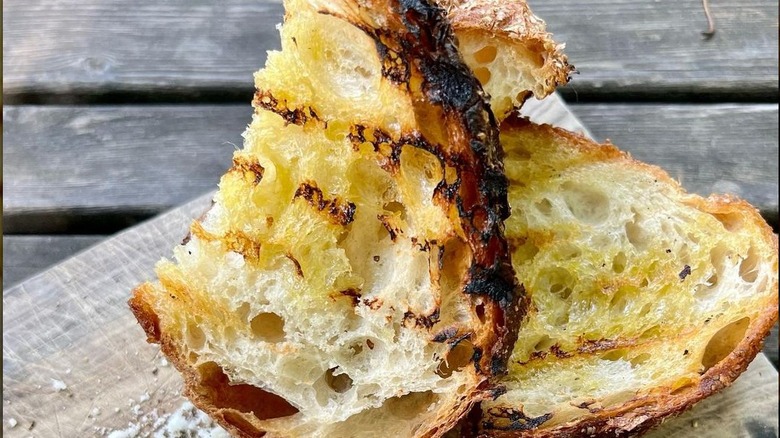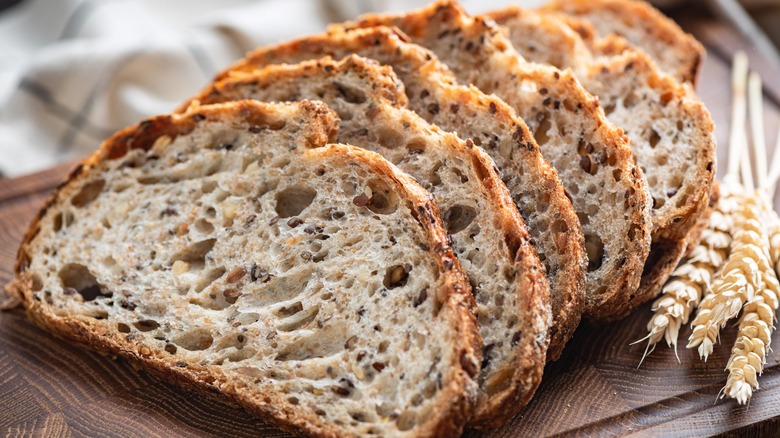8 Types Of Bread You Can Use For Bruschetta
Italy is a virtual wonderland when it comes to antipasti (or appetizers). But no Italian app may match the popularity, simplicity, and deliciousness of bruschetta. This classic dish is made by grilling or toasting bread, rubbing it with garlic, then drizzling extra-virgin olive oil over the top. Additional toppings can be added, as well, such as diced tomatoes seasoned with salt.
Of course, there are plenty of regional variations throughout Italy. In Calabria (a Southern Italian region forming the toe of the nation's so-called boot), bruschetta is dressed up with pepper and oregano, while you'll find it topped with cured meat, cheese, and beans elsewhere in the country. Of course, no matter the toppings you choose, they would prove useless without the right bread.
Essentially, bruschetta bread should be hearty enough to stand up to grilling and dense enough to support the wet ingredients without collapsing. Common options include baguettes and pagnotta (a round country bread similar to ciabatta), but those are far from the only choices. With that in mind, keep reading to discover the many types of bread you can use for bruschetta.
Baguette
Bruschetta is as Italian as they come, so it might seem disrespectful to highlight France's beloved baguette as a top bread option for this appetizer. Yet we do it with good reason. The standard diameter of a baguette is about 2 inches or so. This is small enough to fit in the palm of your hand, yet large enough to support plenty of toppings — resulting in perfectly sized bruschetta every time.
When it comes to texture, baguettes also have a crispy exterior that toasts evenly without becoming excessively crunchy. This provides excellent structural integrity, staying firm even in the presence of a generous olive oil pour and juicy tomatoes. At the same time, the interior of the baguette retains a soft, fluffy texture that provides a satisfying contrast.
Flavor-wise, baguettes are refreshingly simple. By French law, they're made with just four ingredients: wheat flour, water, salt, and yeast. The resulting bread is neither too bland, nor too salty. Instead, it provides a subtle nuttiness that nicely complements sharp garlic, fruity olive oil, and the umami of tomatoes.
Pagnotta
In the United States, classic bruschetta recipes often call for baguettes. After all, they're widely available and (as we saw in the previous section) well-suited to the task. But despite America's love affair with baguette-based bruschetta, you won't often see the appetizer served on French bread in Italy. Blame it on national pride or tradition, but Italians likely prefer their bruschetta on pagnotta: a large, round, rustic style of bread.
Pagnotta is often made from durum wheat flour – a type of hard wheat high in protein, minerals, and vitamins — and its high protein content ensures a sturdy loaf. A robust bread was more of a necessity in the past given the traditional bruschetta preparation called for roasting it over coals. Of course, nowadays, many toast bruschetta bread in the oven instead. Beyond its structural benefits, durum flour contributes a subtle nutty flavor to the bread, providing just the right contrast to the savory and salty toppings without overpowering them.
Ciabatta
Pagnotta may be the gold standard when it comes to Italian bruschetta bread. But it's hard to find outside of Italy, which is where ciabatta comes in. Although less common than, say, baguettes or sourdough, you can usually find ciabatta at your local bakery. Of course, this widespread availability is pretty incredible considering ciabatta is a fairly new bread product. Created by an Italian baker, Arnaldo Cavallari, in 1982, the bread was inspired by French baguettes — or, more accurately, ciabatta was created to steal some of France's bread-making thunder.
It isn't hard to see the similarities between the two bruschetta options. Like baguettes, ciabatta has an elongated form, albeit one that's flatter and wider. They also resemble each other flavor-wise, though ciabatta is a bit tangier, which likely results from a fermentation process lasting up to 24 hours. While some might find that the tanginess enhances simple bruschetta ingredients, others might find it too strong. Likewise, ciabatta's characteristic large holes aren't necessarily ideal for supporting toppings. Despite these minor drawbacks, it's a tasty alternative to more traditional bruschetta bread options.
Sourdough
If you're open to a bit of bruschetta experimentation while still honoring the traditional recipe (or just want to brag about your starter), consider using fresh baked sourdough bread. With a high moisture content, sourdough offers a golden-brown crust paired with a pillowy interior. Sourdough's natural acidity also makes it an economical choice, as even days-old bread can be used for bruschetta without sacrificing much in the way of texture or flavor.
Nutrition-wise, it also offers some benefits other breads don't. The fiber in sourdough bread feeds beneficial gut bacteria, which aids in digestion. Of course, while the nutritional benefits are nothing to turn your nose up at, it's sourdough bread's tanginess that elevates it to bruschetta royalty. The lactic and acetic acids from the fermentation process give sourdough its distinctive tang, something that enlivens any relatively simple toppings. This flavor also balances out the sweetness of olive oil and the acidity of tomatoes, creating a complex, palate-pleasing experience few other breads can replicate.
Focaccia
While ciabatta is a relatively recent addition to the Italian bread canon, focaccia is one of the oldest. Its origins likely trace back to ancient Italy, where simple, unleavened flatbread was prepared out of just flour, water, and salt. This simple recipe allowed for easy cooking, making it a staple in households where hearth cooking was the norm. Naturally, the recipe has evolved over time, with yeast and olive oil becoming essential ingredients, as well, making it well-suited for bruschetta.
There are plenty of regional variations, but at its core, focaccia is golden brown, slightly salty, and fluffy in the center. Italians enjoy it as an appetizer or snack, but it's equally popular as a starting place for pizzas or sandwiches. Since bruschetta is essentially a simple open-faced sandwich, using focaccia as a base is a natural choice. The only caveat with this pairing is to coordinate the toppings. For example, roasted garlic focaccia pairs well with tomatoes and olive oil, but sardenaira, a type of focaccia topped with anchovies or sardines, might steal the spotlight from traditional bruschetta.
Tuscan bread
Many mass-produced bread products in the U.S. are full of preservatives and flavor stabilizers that may pose health risks. What's more, numerous store-bought breads are loaded with salt, with some varieties containing as much sodium as potato chips. However, the issue of sodium content in bread isn't the same concern for people in Central Italy. After all, some bread in Central Italy is made without salt, including pane Toscano (or Tuscan bread). While the lack of salt makes Tuscan bread too bland to eat alone, it's great for sopping up soups and sauces — and for making bruschetta.
It may not be a conventional bruschetta bread, but pane Toscano has several qualities that make it an ideal alternative. To begin with, its neutral flavor complements oily and salty foods without overpowering them. Since bruschetta uses lots of olive oil and salted tomatoes, unassuming Tuscan bread acts as a blank canvas, allowing the quality of the other ingredients to shine. When it comes to texture, pane Toscano's dense chewiness allows it to absorb lots of liquid without becoming mushy — perfect for supporting all of that quality olive oil and tomato juice.
Filone
There's a good chance you haven't heard of filone, but its place in many Italians daily life is as central as that of baguettes in France. More than that, filone's recipe is almost unbelievably simple, and consists of basic ingredients such as flour, water, salt, and yeast. Once baked, it yields a long, oval loaf with a crispy crust and light interior. On the palate, it's reminiscent of sourdough but with a milder tang, and these qualities make filone a good candidate for bruschetta.
Like baguettes, the bread's round, elongated shape provides an ideal amount of surface area — deftly straddling the line between large enough for toppings and small enough for one-handed eating. Texturally, its crispy exterior takes well to toasting, while remaining sturdy enough to support the weight of the toppings. Meanwhile, the airy interior eagerly soaks up the flavors of the extra virgin olive oil and tomato juice, ensuring each bite is as tasty as the last one.
Whole wheat bread
As far as appetizers go, it doesn't get much healthier than bruschetta. Consisting of vitamin-packed tomatoes, heart-healthy olive oil, and immune-boosting garlic, it covers many of your nutritional bases. Unfortunately, the toppings do most of the heavy lifting, as standard bread choices like baguettes and ciabatta don't add much in the way of nutritional benefits. So, if you want to maximize those benefits of bruschetta, choosing a nutrient-rich bread like whole wheat can make a big difference.
Like other top bruschetta bread contenders, whole wheat is hearty and toasts like a dream. The exterior develops a golden hue and crunchy texture, while the inside remains pleasantly pillowy. When it comes to flavor, whole wheat bread is nutty and slightly sweet, which helps mellow out the acidity of the tomatoes.
As with the other less conventional breads on this list, though, using whole wheat bread comes with a warning: avoid commercially-made whole wheat breads. Instead, opt for a quality loaf from a bakery. Mass-produced bread tends to lack the tensile strength and heft of loaves from a bakery, making it prone to tearing, and too weak to support a mound of diced tomatoes.
